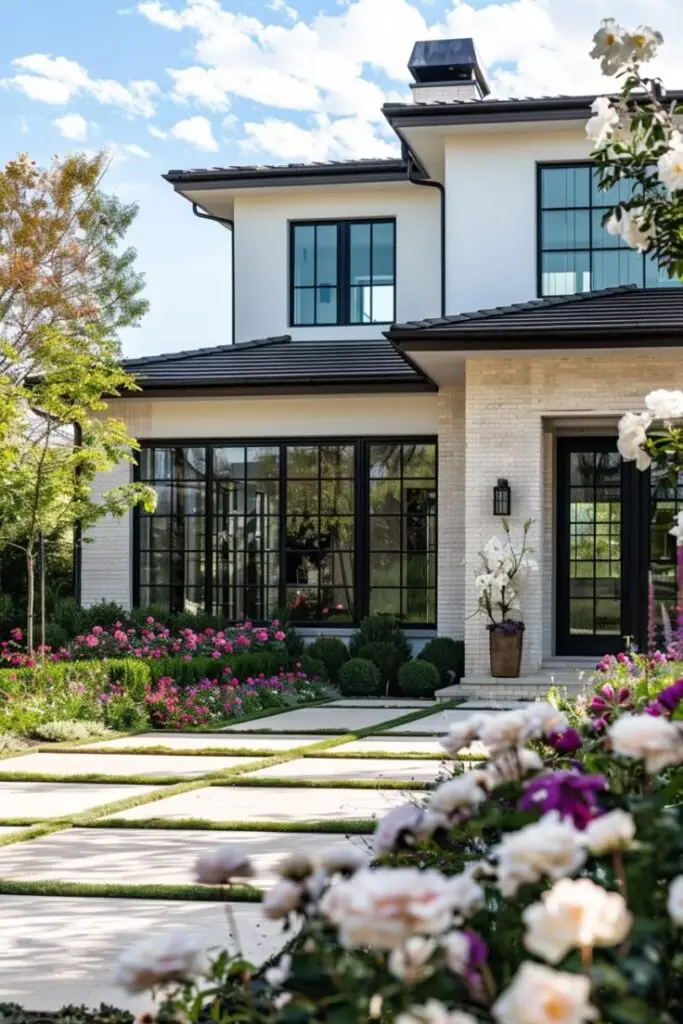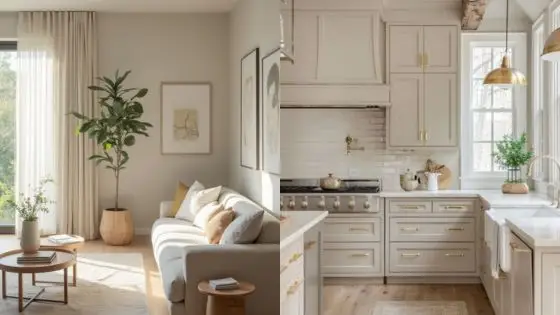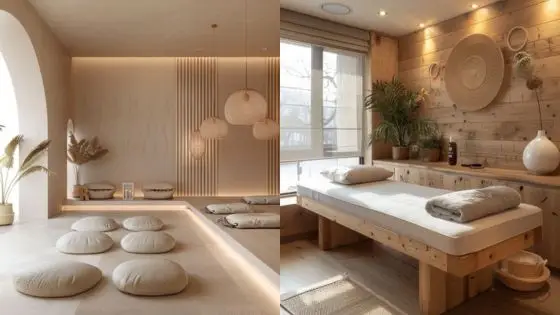Transforming your home’s exterior is one of the most impactful ways to enhance curb appeal and express your personal style. From vibrant wall art to architectural accents, exterior house decor allows you to create a welcoming impression before anyone even steps inside. The right outdoor decorations can dramatically transform blank exterior walls while reflecting your personality and complementing your home’s architectural style.
Whether you’re considering oversized metal wall art, decorative planters, or weather-resistant wall hangings, there are countless options to elevate your home’s exterior appearance. Many homeowners are discovering creative solutions for previously overlooked spaces, turning bland exterior walls into striking focal points. You can find these decorative elements at home improvement stores, specialty retailers, or even create custom pieces that perfectly match your vision.
Spring 2025 brings exciting new trends in exterior decor, with emphasis on sustainable materials and versatile pieces that transition between seasons. From charming garden-inspired designs to modern geometric patterns, you can easily refresh your home’s exterior without undertaking major renovations. Your outdoor walls offer valuable decorative real estate—consider them blank canvases waiting for your creative touch.


Design Principles for Exterior House Decor
Effective exterior house decor balances aesthetic appeal with practical considerations. Creating an inviting and cohesive outdoor space requires attention to architectural elements, material selection, and personal preferences.
Harmonizing with Architecture
Your home’s architectural style should guide your exterior decor choices. Victorian homes benefit from ornate details and period-appropriate fixtures, while modern designs call for clean lines and minimalist elements.
Pay attention to the proportions of decorative items. Oversized house numbers, light fixtures, or planters can make a statement, but they must remain in scale with your facade.
Color coordination is crucial. Select exterior decor that complements your home’s primary colors and materials. Even contrasting accents should exist within a coherent color palette that highlights your home’s best features.
Consider sightlines and focal points when placing decor. Entry doors, windows, and architectural features deserve enhancement rather than competition from poorly placed decorative elements.
Considering Durability and Maintenance
Select materials specifically designed to withstand your local climate conditions. Coastal areas require salt-resistant metals, while areas with extreme temperature fluctuations need materials that won’t crack or fade quickly.
Quality weatherproof finishes extend the life of exterior decor. Look for UV-resistant paints, powder-coated metals, and sealed natural materials that will maintain their appearance over time.
Establish a regular maintenance schedule for your exterior elements. Seasonal cleaning and occasional resealing or touch-ups can prevent costly replacements and keep your home looking fresh.
Consider the long-term commitment when selecting elaborate decor. Complex water features or extensive lighting systems require ongoing maintenance that you should be prepared to manage.
Incorporating Personal Style
Express your personality through thoughtfully chosen exterior decor. Distinctive door hardware, unique mailboxes, or custom house numbers create character without overwhelming your home’s design.
Layer decorative elements to create depth and interest:
- Architectural accents (shutters, trim details)
- Lighting fixtures (wall sconces, path lights)
- Living elements (container gardens, window boxes)
- Seasonal decor (wreaths, door mats)
Remember that restraint often yields more sophisticated results than excess. Select fewer, higher-quality pieces rather than filling every available space with decorative items.
Test your design choices before committing. Use temporary installations or even photo editing to visualize how new decor will look on your home’s exterior before making permanent changes.


Choosing Materials for Outdoor Decor
Selecting the right materials for your exterior decor determines both its aesthetic appeal and longevity. The materials you choose must withstand environmental challenges while complementing your home’s architectural style.
Natural vs. Synthetic Options
Natural materials offer classic beauty and often blend harmoniously with outdoor environments. Wood options like teak and cedar possess natural oils that make them resistant to decay and insects. Teak, though expensive, weathers beautifully to a silver-gray patina over time.
Stone elements provide durability and timeless appeal. Materials like slate, limestone, and granite create focal points through pathways, walls, or decorative elements.
Synthetic alternatives have advanced significantly in recent years. High-quality composites mimic the look of wood without the maintenance requirements. These materials resist warping, splitting, and fading.
Polymers and plastics designed for outdoor use offer affordability and versatility. Many synthetic options are UV-stabilized to prevent color degradation from sun exposure.
Weather-Resistant Solutions
Climate considerations should drive your material choices. In areas with high humidity or rainfall, aluminum and powder-coated steel resist rust and corrosion better than wrought iron.
Porcelain tiles make excellent outdoor wall coverings due to their impermeability and frost resistance. They’re available in various textures and can simulate stone or wood aesthetics.
For coastal environments, opt for marine-grade stainless steel hardware and fixtures to withstand salt air. Regular mild steel will quickly deteriorate in these conditions.
Consider weight and stability for areas prone to high winds. Heavier materials like concrete and stone stay put during storms, while lighter items may need secure anchoring.
Maintenance requirements vary significantly between materials. Evaluate your willingness to sand, seal, or refinish regularly before committing to maintenance-intensive options.


Furniture and Accessories for Exterior Spaces
The right selection of furniture and decorative elements transforms your outdoor areas into functional, beautiful extensions of your home. Each piece you choose should balance style, durability, and practicality while complementing your home’s exterior aesthetic.
Selecting Outdoor Furniture
When choosing outdoor furniture, prioritize weather-resistant materials like teak, aluminum, or all-weather wicker that withstand the elements. These materials require minimal maintenance while offering longevity even in harsh conditions.
Consider your space dimensions before purchasing. A crowded patio feels cluttered, while too little furniture makes spaces feel empty and unwelcoming. Measure your area and allow for 3-4 feet of walking space around furniture groupings.
Create conversation areas with comfortable seating arrangements. Sectionals work well for large families, while bistro sets suit intimate spaces. Look for pieces with quick-drying cushions featuring fade-resistant fabrics.
Multi-functional pieces offer tremendous value. Storage benches provide both seating and a place to tuck away garden tools. Nesting tables can expand when needed for entertaining and contract for daily use.
Decorative Accents
Outdoor rugs define spaces and add warmth underfoot. Choose synthetic options specifically designed for exterior use that resist mold and mildew growth.
Wall art designed for outdoor display adds personality to blank exterior walls. Metal sculptures, weather-resistant prints, and mosaic pieces withstand the elements while creating visual interest.
Pillows and throws in weather-resistant fabrics introduce color and pattern without major commitment. They can be swapped seasonally to refresh your space affordably.
Lanterns and decorative lighting serve both functional and aesthetic purposes. Solar options eliminate the need for electrical connections, while battery-operated candles provide ambiance without fire hazards.
Garden decor like fountains add soothing sounds that mask traffic noise. Strategically place decorative planters to add greenery at varying heights throughout your space.
Functional Additions
Outdoor storage solutions keep spaces tidy and protect items from weather damage. Deck boxes, cabinets, and shelving units designed for exterior use maintain organization while resisting rust and deterioration.
Consider shade structures like umbrellas, pergolas, or retractable awnings to extend the usability of your outdoor spaces during hot summer days. Look for UV-resistant materials that won’t quickly fade.
Outdoor curtains add privacy and style while blocking harsh sunlight. Choose water-repellent, mildew-resistant fabrics that maintain their appearance through changing weather conditions.
Add versatility with serving carts that move easily between cooking and dining areas. These practical additions keep beverages and serving items within reach when entertaining.
Weather-resistant cabinetry creates outdoor kitchen functionality. Specialized materials withstand temperature fluctuations while providing convenient storage for outdoor dining necessities.


Outdoor Wall Decor and Lighting
Transforming your home’s exterior involves thoughtful selection of wall decorations and strategic lighting placement. These elements work together to enhance curb appeal while reflecting your personal style.
Wall Embellishments
Metal sculptures create dramatic focal points on exterior walls, especially when positioned to catch natural light. Consider weather-resistant art pieces that complement your home’s architectural style.
Plants can serve as living wall decor through mounted planters or climbing vines on decorative trellises. Artificial boxwood panels offer a low-maintenance alternative that provides year-round greenery without upkeep.
Signs and plaques personalize your space while adding character. Choose materials like ceramic, metal, or weather-treated wood that withstand outdoor conditions.
Decorative mirrors can make smaller outdoor areas appear more spacious while reflecting light and garden views. Select frames specifically designed for exterior use to prevent deterioration.
Illuminating Your Space
Wall-mounted lighting serves dual purposes of security and aesthetics. Position fixtures at entry points and along pathways to ensure safe navigation after dark.
Solar-powered options eliminate wiring concerns while reducing energy costs. Modern solar lights include features like motion sensors and multiple lighting modes for versatility.
Decorative sconces frame doorways and highlight architectural features when placed symmetrically. Choose fixtures that complement your home’s style—rustic lanterns for traditional homes or sleek minimalist designs for contemporary exteriors.
Consider the light temperature when selecting bulbs. Warm white (2700-3000K) creates an inviting atmosphere, while cooler tones (4000K+) provide better visibility for security purposes.


Landscaping as Living Decor
Landscaping transforms your exterior space into a vibrant extension of your home, blending natural elements with structural features. Well-designed outdoor areas create visual appeal, increase property value, and provide functional living spaces.
Incorporating Plants and Greenery
Plants are the foundation of any landscape design, offering color, texture, and seasonal interest. Choose a mix of perennials and annuals to ensure year-round visual appeal. Evergreen shrubs provide structure and permanence, while flowering plants add pops of color throughout seasons.
Consider layering plants of different heights to create depth and dimension. Tall trees frame the house, mid-height shrubs add structure, and ground covers provide interesting textures at eye level.
For farmhouse-inspired landscapes, incorporate cottage garden favorites like lavender, hydrangeas, and ornamental grasses. These plants bring a relaxed, lived-in quality to your outdoor spaces while requiring minimal maintenance.
Vertical gardening using trellises or wall planters maximizes limited space in urban settings. Container gardens offer flexibility for rearranging your landscape as design preferences change.


Garden Features and Structures
Structural elements complement your plantings and anchor your landscape design. Pathways crafted from natural stone, brick, or gravel guide visitors through your garden while adding visual interest and texture.
Consider these impactful additions:
- Water features: Fountains, ponds, or simple birdbaths create focal points and attract wildlife
- Garden arbors: Frame entrances and support climbing plants
- Decorative fencing: Adds boundary definition with vintage charm
- Outdoor lighting: Highlights landscape features and extends enjoyment into evening hours
Vintage garden elements like weathered benches, repurposed containers, or antique garden tools bring character to outdoor spaces. Look for authentic pieces at flea markets or online marketplaces to incorporate genuine history.
For year-round appeal, include permanent features like stone walls, pergolas, or garden sculptures that maintain visual interest even during dormant seasons.
- 56shares
- Facebook0
- Pinterest56
- Twitter0



